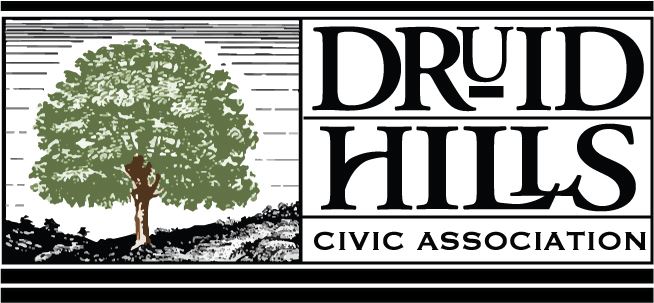| SERVING THE NEIGHBORHOOD OF DRUID HILLS A COMMUNITY NESTLED IN THE HEART OF ATLANTA, GEORGIA |
Druid Hills History
With its beautiful linear park and parkways designed at the turn of the 20th century by Frederick Law Olmsted, the Druid Hills Historic District richly deserves its designation on the National Register of Historic Places. Today, it resides remarkably near the center of Atlanta’s sprawling metropolitan area.
Some find it hard to believe that this magnificent urban neighborhood was conceived and executed as one of Atlanta’s first suburbs. Yet it continues to evoke the past with its winding roads, eclectic architecture, and green canopy. The U.S. Department of the Interior once declared Druid Hills to be “significant as the finest example of late 19th and early 20th century comprehensive planning and development in the Atlanta area, and one of the finest period suburbs in the Southeast.”
The U.S. Department of the Interior once declared Druid Hills to be “significant as the finest example of late 19th and early 20th century comprehensive planning and development in the Atlanta area, and one of the finest period suburbs in the Southeast.”
In the early 1890s, Atlanta entrepreneur Joel Hurt, who had imaginatively developed transportation, utilities, and real estate in the city, assembled a large tract of land for residential use. He hired Frederick Law Olmsted, America’s premier landscape architect, to plan his “ideal residential suburb.” To view correspondence regarding the creation of Druid Hills between the Olmsted Firm and the Kirkwood Land Company, click here.
By the time Olmsted began to design Druid Hills in 1893, he had already completed many prominent projects including Central Park in New York City, the grounds of the United States Capitol, the Biltmore Estate in North Carolina, Prospect Park in Brooklyn, and the Stanford University campus. He also designed numerous park and parkway systems Boston, Chicago, and other cities.
Early in his career Olmsted planned (with his colleague Calvin Vaux) the community of Riverside, Illinois, as the prototype of a planned suburb. Druid Hills, designed near the end of his career, demonstrates the evolution of his ideas about the relation of suburbs to the city. In fact, Olmsted expressed his philosophy of suburban living in an 1890 letter to Joel Hurt; he envisioned the homeowner returning hot and tired from the city to homes “well shaded by handsome, umbrageous, permanently thrifty trees” in a neighborhood with a “pleasing rural, or, at least, semi-rural, character of scenery . . . to be permanently enjoyed.”
He envisioned the homeowner returning hot and tired from the city to homes “well shaded by handsome, umbrageous, permanently thrifty trees” in a neighborhood with a “pleasing rural, or, at least, semi-rural, character of scenery . . . to be permanently enjoyed.”
Olmsted’s vision of suburban living was eventually realized in Druid Hills. However, after several visits to Atlanta to meet with Hurt, financial setbacks halted the project for several years. Before work resumed the aging Olmsted retired and Hurt hired the successor firm of Olmsted Brothers to develop the design proposed by the elder landscape architect.
Significance
Landscape and urban scholars have established that Druid Hills represents a major innovation in suburban design. Its central corridor, Ponce de Leon Avenue, with separated vehicular and pleasure drives, functions as the central promenade of the community. It is a linear version of the traditional village green. Each of Ponce de Leon’s median parks is distinct in its landscaping. The parks range from relatively open greenswards to nearly impenetrable woods.
In an early proposal for Druid Hills, Olmsted wrote of“roads of moderate grace and curves, avoiding any great disturbance of the natural topography.” The neighborhood’s streets follow the natural terrain and its open spaces remind us of the picturesque vistas integral to late 19th-century landscape planning.
In an early proposal for Druid Hills, Olmsted wrote of“roads of moderate grace and curves, avoiding any great disturbance of the natural topography.”
Modern development in Druid Hills preserved the environment of parks, streetscapes, and landscapes in the spirit of Olmsted’s original concept. Scholars believe the area fulfills the three major components of his vision of 20th century suburban living:
– a park or public space as the central focus of the suburbs
– a parkway conceived as both a connector and pleasure drive
– residences on large acreages that face the parks and winding streets.
Many well-known Atlanta architects including Neel Reid, Philip Trammel Shutze, Ernest Ivey, and Lewis Crook, Jr., are represented in Druid Hills.
Influence
Through the years, Olmsted’s design for Druid Hills strongly influenced suburban planning throughout Atlanta. Architects who gained experience from working in our neighborhood later shaped Ansley Park, Morningside, Garden Hills, and Avondale Estates. Design elements were emulated in Brookwood Hills, and the West Paces Ferry area. More recently, office parks that emphasize green space and natural terrain have harked back to Olmsted. In fact, some scholars maintain that had it not been for Frederick Law Olmsted’s Druid Hills, Atlanta would not be the park-like city it is today.
Integrity
The vigilance of the Druid Hills Civic Association has enabled Olmsted’s last major suburb to retain its original lot configurations and open spaces. The Druid Hills National Register Historic District, about 1,400 acres, was designated in two stages in 1975 and 1979. “In a national context, Druid Hills is a rare example of Olmsted’s design intentions intact in its principal features,” the U.S. Department of the Interior has attested.
“In a national context, Druid Hills is a rare example of Olmsted’s design intentions intact in its principal features,” the U.S. Department of the Interior has attested.
Frederick Law Olmsted’s vision of suburban living endures today in the rolling landscapes and winding roads of Druid Hills.
To learn more about Frederick Law Olmsted and the Olmsted Brothers, please visit www.olmsted.org.
See Druid Hills in the 1970's |

